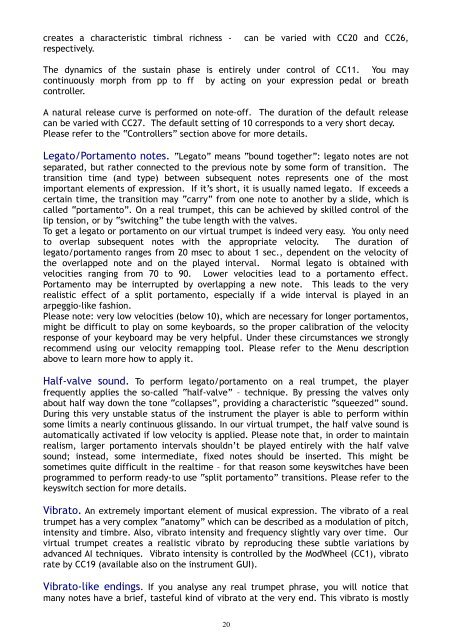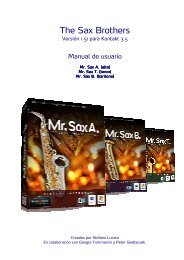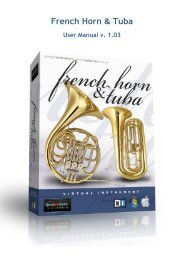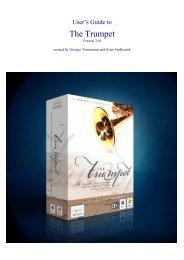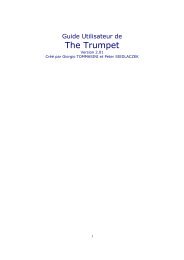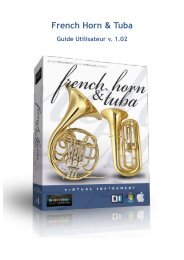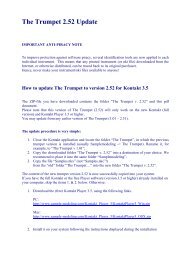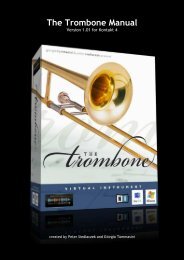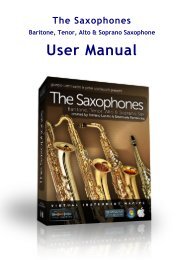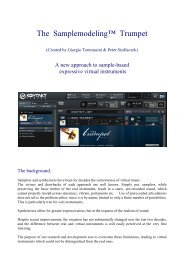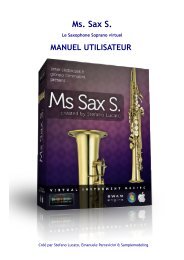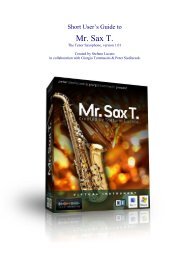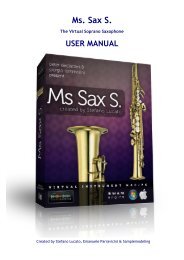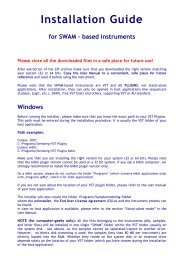The Trumpet - Sample Modeling
The Trumpet - Sample Modeling
The Trumpet - Sample Modeling
Create successful ePaper yourself
Turn your PDF publications into a flip-book with our unique Google optimized e-Paper software.
creates a characteristic timbral richness -<br />
respectively.<br />
can be varied with CC20 and CC26,<br />
<strong>The</strong> dynamics of the sustain phase is entirely under control of CC11. You may<br />
continuously morph from pp to ff by acting on your expression pedal or breath<br />
controller.<br />
A natural release curve is performed on note-off. <strong>The</strong> duration of the default release<br />
can be varied with CC27. <strong>The</strong> default setting of 10 corresponds to a very short decay.<br />
Please refer to the “Controllers” section above for more details.<br />
Legato/Portamento notes. “Legato” means “bound together”: legato notes are not<br />
separated, but rather connected to the previous note by some form of transition. <strong>The</strong><br />
transition time (and type) between subsequent notes represents one of the most<br />
important elements of expression. If it’s short, it is usually named legato. If exceeds a<br />
certain time, the transition may “carry” from one note to another by a slide, which is<br />
called “portamento”. On a real trumpet, this can be achieved by skilled control of the<br />
lip tension, or by “switching” the tube length with the valves.<br />
To get a legato or portamento on our virtual trumpet is indeed very easy. You only need<br />
to overlap subsequent notes with the appropriate velocity. <strong>The</strong> duration of<br />
legato/portamento ranges from 20 msec to about 1 sec., dependent on the velocity of<br />
the overlapped note and on the played interval. Normal legato is obtained with<br />
velocities ranging from 70 to 90. Lower velocities lead to a portamento effect.<br />
Portamento may be interrupted by overlapping a new note. This leads to the very<br />
realistic effect of a split portamento, especially if a wide interval is played in an<br />
arpeggio-like fashion.<br />
Please note: very low velocities (below 10), which are necessary for longer portamentos,<br />
might be difficult to play on some keyboards, so the proper calibration of the velocity<br />
response of your keyboard may be very helpful. Under these circumstances we strongly<br />
recommend using our velocity remapping tool. Please refer to the Menu description<br />
above to learn more how to apply it.<br />
Half-valve sound. To perform legato/portamento on a real trumpet, the player<br />
frequently applies the so-called “half-valve” – technique. By pressing the valves only<br />
about half way down the tone “collapses”, providing a characteristic “squeezed” sound.<br />
During this very unstable status of the instrument the player is able to perform within<br />
some limits a nearly continuous glissando. In our virtual trumpet, the half valve sound is<br />
automatically activated if low velocity is applied. Please note that, in order to maintain<br />
realism, larger portamento intervals shouldn’t be played entirely with the half valve<br />
sound; instead, some intermediate, fixed notes should be inserted. This might be<br />
sometimes quite difficult in the realtime – for that reason some keyswitches have been<br />
programmed to perform ready-to use “split portamento” transitions. Please refer to the<br />
keyswitch section for more details.<br />
Vibrato. An extremely important element of musical expression. <strong>The</strong> vibrato of a real<br />
trumpet has a very complex “anatomy” which can be described as a modulation of pitch,<br />
intensity and timbre. Also, vibrato intensity and frequency slightly vary over time. Our<br />
virtual trumpet creates a realistic vibrato by reproducing these subtle variations by<br />
advanced AI techniques. Vibrato intensity is controlled by the ModWheel (CC1), vibrato<br />
rate by CC19 (available also on the instrument GUI).<br />
Vibrato-like endings. If you analyse any real trumpet phrase, you will notice that<br />
many notes have a brief, tasteful kind of vibrato at the very end. This vibrato is mostly<br />
20


